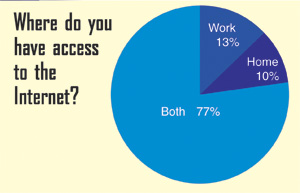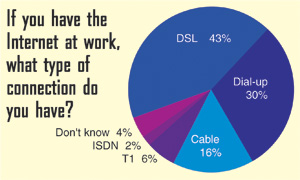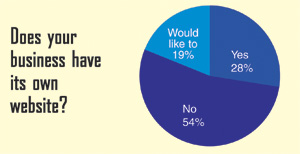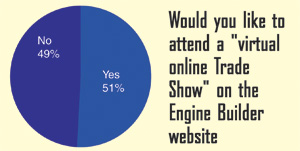Twenty years ago, the idea of doing business through your computer was
unheard of. Sure shops HAD computers…and some of them even turned them
on once in a while and used them for printing work orders or perhaps
even a printed reminder card to a customer now and then.
Ten years ago, the internet was booming. You could buy everything from
cars to cat food on line. It seemed that the dot-coms were offering
businesses of every size fantastic marketing and sales opportunities.

Then came 2000, when the Internet bubble burst. What was booming went
flat and many people predicted that the World Wide Web was just another
fad, destined to take its place in history beside the Pet Rock, Flapper
dancers and the Tucker.
But a funny thing happened on its way to obscurity – the Internet
became viable again. Today, it is far from being a fad. It has become a
legitimate business tool for the engine building industry and shop
owners, equipment suppliers and parts manufacturers are all
beneficiaries of the power of internet marketing.
According to a survey conducted recently by Babcox Research, Engine
Builder readers still lag behind much of the automotive industry with
regard to their internet presence. According to our survey, 28 percent
of shops have their own business Web site. But while this number seems
disturbingly low, especially in light of the "www.something.com"
addresses plastered seemingly everywhere, it IS an increase from last
year. In last year’s Machine Shop Market Profile, we reported that only
18 percent of shops said they had a Web presence.

While 72 percent of this year’s respondents say they don’t currently
have a Web site, 19 percent of them say they would like to…so the
number could be much closer to 50/50 next year at this time.
Results of our study indicate that about 73 percent of Engine Builder
subscribers have access to the Internet either at home or at work, but
most often in both locations. An overwhelming 77 percent of respondents
say they utilize the Web while at home and while on the clock.
But while the perception of the Internet offering only entertainment
value still persists in some circles, the fact of the matter is that
the research and information services available online bring
significant value to businesses as well.
In their infancy, Web sites were often static, information-only pages
that provided little more information than a simple Yellow Pages ad.
Many shops were satisfied that this "Web presence" was, though simple
and cheap, satisfactory. But with the advent of Web 2.0, many more Web
sites have become feature-rich portals that include audio, video and
many other user-defined characteristics and functions.
 A brief explanation is in order here: Web 2.0 is not an upgraded
A brief explanation is in order here: Web 2.0 is not an upgraded
version of the Internet that you’ll have to install on your computer.
In fact, despite its similarity in name to every software package that
has become obsolete thanks to a newer, more robust version, it isn’t
software at all. Instead, Web 2.0 is simply a buzzword that refers to
the internet as a more user-friendly, adaptable platform. Granted,
those static pages were about all you could handle back in the old days
of dial-up Web access. Today’s active pages create real problems for
users who do not have high-speed internet, although according to our
survey, those low-tech numbers are falling. 30 percent of users tell us
they are tethered to dial-up accounts; 43 percent have DSL. Cable
brings the internet into the homes and businesses of 16 percent of
readers while 6 percent use a T1 line. ISDN (short for integrated
services digital network, another method of transmitting
communications) is used by 2 percent. About 4 percent of users say
they’re not sure of their connection.

The majority of users spend between 2-6 hours per week on the internet
while at work. 27 percent say they limit their internet use to one hour
or less per week. At the other end of the scale, 10 percent of readers
say they spend 7-9 hours per week online, and 6 percent admit to
spending over 9 working hours per week on the Internet.
As we’ve heard from leading shop owners and business professionals,
successful shops will need to begin accounting for this time if they
aren’t already.
In the vast majority of cases, of course, time spent online is directly
related to work activities. Respondents say nearly 90 percent of the
time they use the internet to locate parts and equipment, research
parts suppliers or manufacturers, research tools and equipment, make
purchases for work, locate specific rebuilding information, source
training information, chat online with the International Automotive
Technicians Network (iATN) or other professional networking sites or
advertise for employees. Only 11 percent of today’s at-work Internet
usage is for "other" purposes. What those uses may be is anyone’s guess…
Shops say that while research is conducted online more and more
frequently, actual ordering is still a ways behind. When asked "Do you
order over the Internet from your main supplier?" 68 percent of
respondents say no. While this may seem odd, given the fact that nearly
every parts supplier has an internet presence and many encourage online
activity, the chance to order parts from a real person still provides a
certain level of comfort.

More than half of respondents (59 percent) admit that they communicate
via e-mail with their suppliers, but only 49 percent say they do the
same with their customers. E-mail can be a great marketing tool, and
does not have to be restricted to simple text-only messages. Today’s
emails can be as feature rich as many Web sites yet still be small
enough in size to allow users with slower access to read them.
Even Engine Builder magazine is taking advantage of the resources
available by producing a bi-weekly e-Newsletter. Send your email
address to [email protected] to receive a sample copy and subscribe for
the automatic mailing.
Having the right tools but keeping them out of the hands of your
workers doesn’t make any more sense in the shop than it does in
cyberspace. Luckily, 73 percent of shops that have Internet access at
work say technicians have access. Since 82 percent of the time, that
access is in the manager’s office, employees are typically not tempted
to waste shop time – probably another reason that the "other" uses of
the Internet are held to just 10 percent.
Internet Sales and Purchases
According to the annual Machine Shop Market Profile, the "average" CER
produces about 15 gas and diesel engines per month. According to the
results of our Internet study, nearly 8 percent of total engine sales
come from online customers. That and the 11 percent of total parts
sales coming from online customers is a compelling reason to have a
functional Web site.
As a business owner, your Web site should be an extension of your
advertising and marketing program, but to be effective it needs to be
user-friendly. The Web site must be easy to get to and then it must be
easy to navigate. Nothing is more frustrating than not being able to
find the information you are looking for on a Web site.
Your site needs to be simple and easy to navigate. When someone visits
your site, you want them to find the info they are looking for quickly.
Otherwise, they may move on to another site.
Your site should also reflect professionalism and competence. If it
looks amateurish there’s a very distinct possibility that you’ll be
bitten by a bad first impression. However, "too much" can be a problem
as well. Large, slow loading graphics, too many pop-up ads and a design
that doesn’t allow easy usability are just as likely to force visitors
away from your site, no matter how appropriate it is for their needs.
You might be the best, most competent shop in the world, but it’s always that first impression that will make or break you.
Search engines are Web sites people use to search for information on
the Internet. Google and Yahoo are two very popular search engines.
According to research, nearly 100 percent of Internet users utilize one
or more search engines – so how can you make sure your site appears on
them?
Most search engines provide Web sites two ways of appearing: natural
(free) and Paid. Natural listings appear based on a variety of factors,
most of the time dictated by the search terms. Paid listings usually
appear above or to the side of Natural listings and are often
identified as advertisements. Search engine marketing companies
typically use paid listings and search engine terms to force your Web
site to the top of the search. These companies can be located – how
else? – on a search engine.
You need to plan on updating your Web site regularly, another way to
keep your site high on the search engines. Some experts believe you
should try to update your site at least once a week. You can do it
yourself, or have your Web designer do it. Of course, it will cost you
additional money to have someone else do it and it really isn’t that
hard once the site is set up. Your designer can easily teach you how.
Updates could be anything, but they’re best if they are something that
will garner the attention of visitors to your site. Give them a reason
to visit your site often. Maybe incorporate a tips section or other
informative area of your site.
According to our survey, here are the features and information provided by engine builder Web sites:
- Company contact information: 96 percent
- Hours of operation: 60 percent
- Engine rebuilding/machining offered: 56 percent
- Collect customer contact information: 28 percent
- Customers can check inventory: 6 percent
- Customers can make appointments: 4 percent
Note that several of these are already interactive, and with
modifications others could be as well. Instead of simply listing your
address, a Google or Mapquest program can give them directions from
their home or business to your location.
Other forms of interactivity can be videos of your machining operations
to not only tell your customers what you offer but show them as well.
The Internet continues to change the way we do business. On-line
shopping is eclipsing in-store buying in many segments of society.
Are their ways you utilize the Internet that we haven’t discussed here?
Feel free to let us know. Send us your Internet marketing success story
(or horror story!) to [email protected]. We’ll publish the best ones in an upcoming edition of our eNewsletter.
Special thanks to Bob Roberts of Babcox Research for the effort involved in gathering these statistics.













